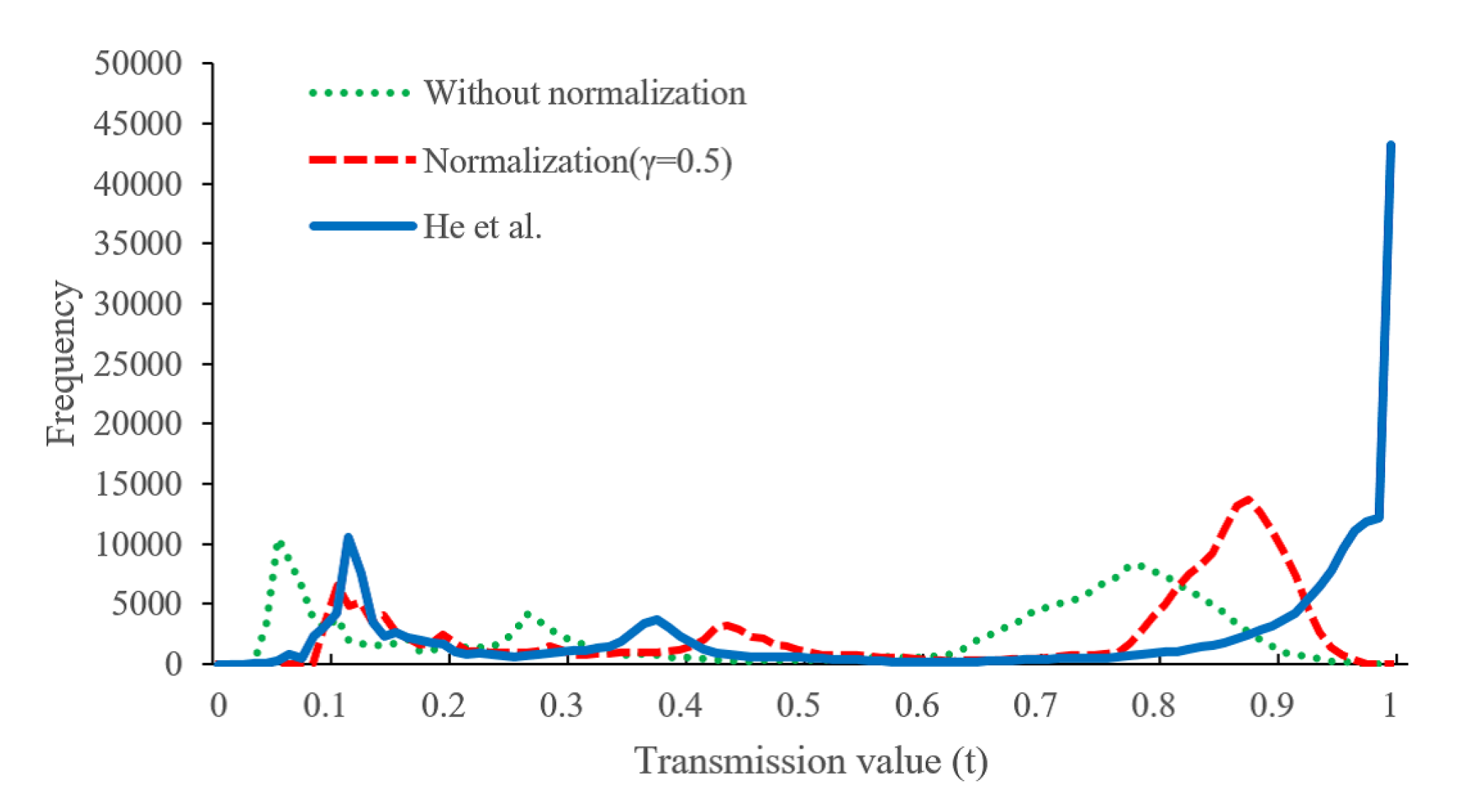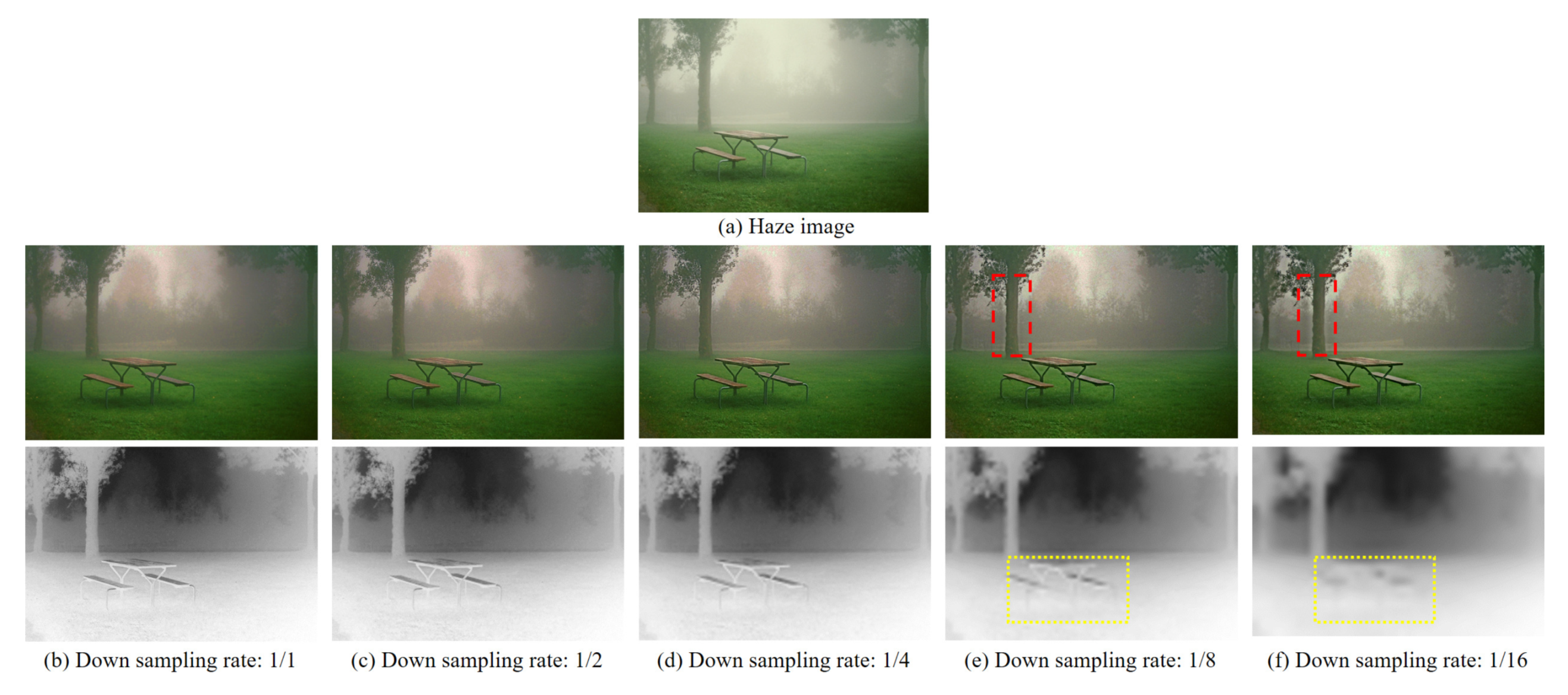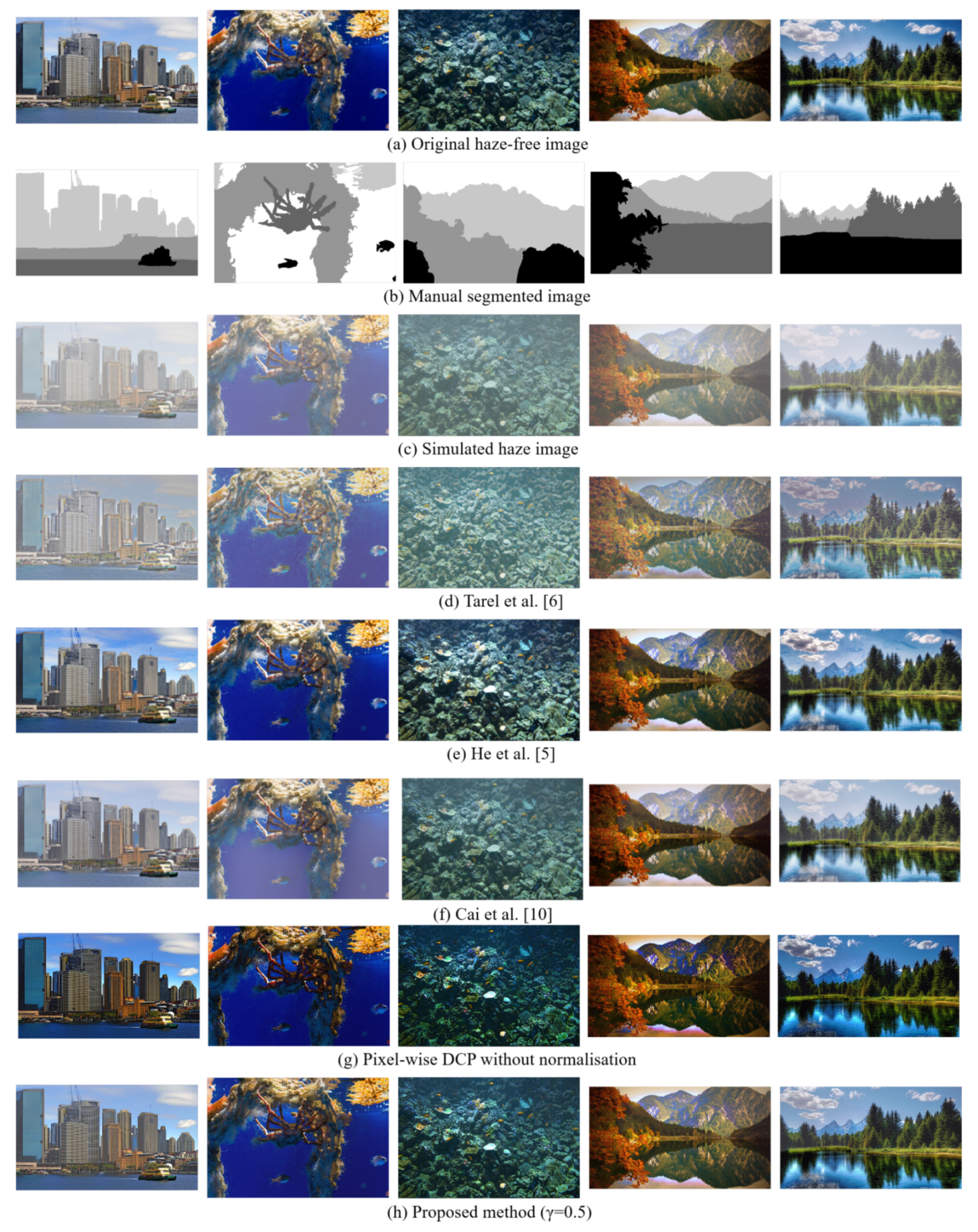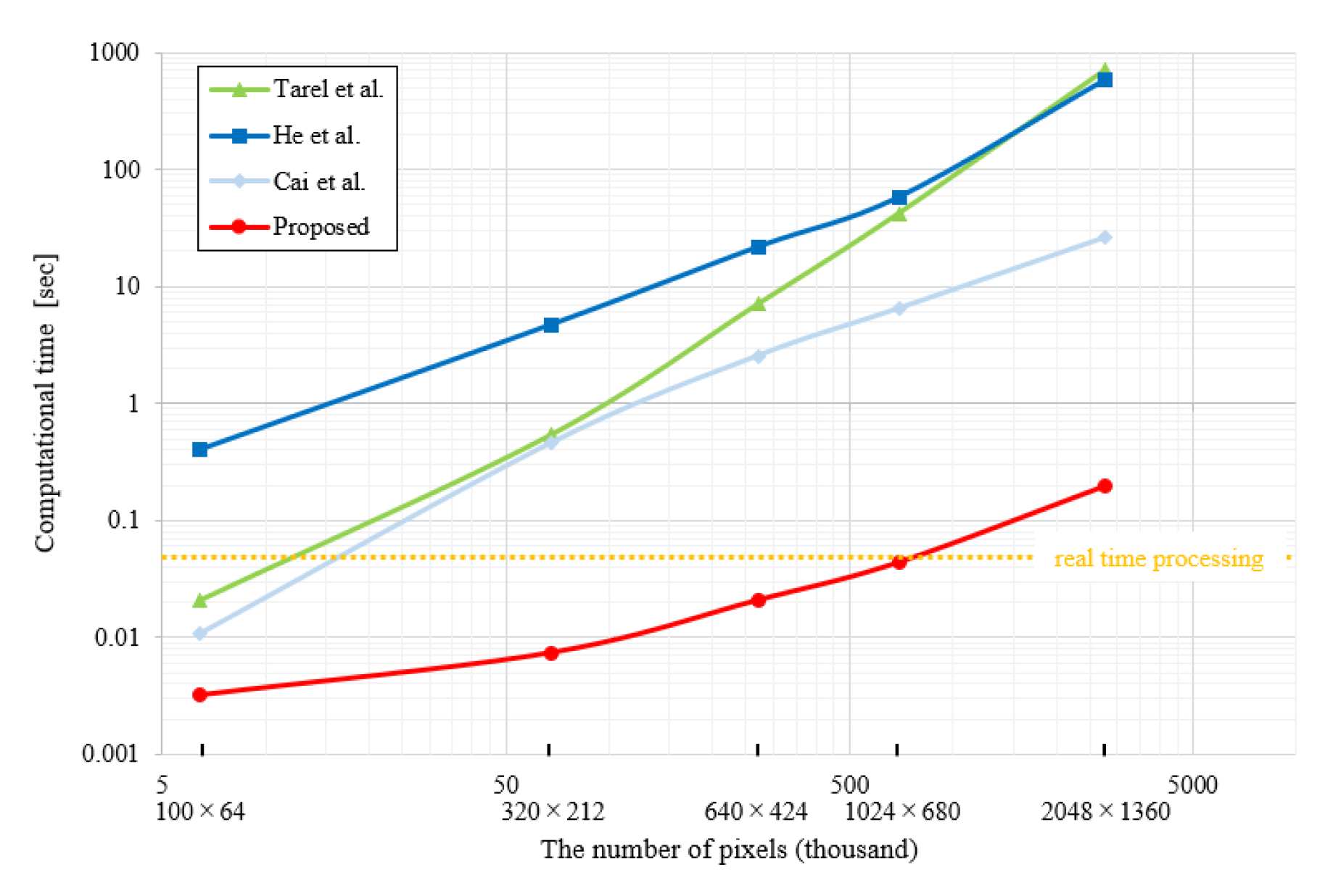Real-Time Haze Removal Using Normalised Pixel-Wise Dark-Channel Prior and Robust Atmospheric-Light Estimation
Abstract
1. Introduction
- (a)
- Normalised pixel-wise DCPOriginal patch-wise DCP method requires high computational cost to refine the transmission map using an image-matting technique. In this paper, we propose a normalised pixel-wise DCP method with no need for refinement of transmission map compared with the patch-wise method.
- (b)
- Accelerating haze removal via down-samplingWe estimate the transmission map and atmospheric light using down-sampled haze image for acceleration. This idea is inspired by [13].
- (c)
- Robust atmospheric-light estimationTo reduce the computational time and improve robustness, we propose a coarse-to-fine search strategy for atmospheric-light estimation.
2. Traditional Dark Channel Prior
2.1. Estimation of Transmission Map
2.2. Estimation of Atmospheric Light
2.3. Estimation of Haze-Removal Image
3. Proposed Method
3.1. Normalized Pixel-Wise Dark Channel Prior
3.2. Acceleration by Down-Sampling
3.3. Robust Atmospheric Light Estimation
4. Results and Discussion
5. Conclusions
Author Contributions
Funding
Acknowledgments
Conflicts of Interest
References
- Narasimhan, S.G.; Nayar, S.K. Chromatic framework for vision in bad weather. In Proceedings of the IEEE Conference on Computer Vision and Pattern Recognition (CVPR), Hilton Head, SC, USA, 13–15 June 2000; Volume 1, pp. 598–605. [Google Scholar]
- Kopf, J.; Neubert, B.; Chen, B.; Cohen, M.; Cohen-Or, D.; Deussen, O.; Uyttendaele, M.; Lischinski, D. Deep photo: model-based photograph enhancement and viewing. ACM Trans. Graph. (TOG) 2008, 27, 116. [Google Scholar] [CrossRef]
- Tan, R.T. Visibility in Bad Weather from a Single Image. In Proceedings of the IEEE Conference on Computer Vision and Pattern Recognition (CVPR), Anchorage, Alaska, 23–28 June 2008; pp. 1–8. [Google Scholar]
- Fatal, R. Single Image Dehazing. ACM Trans. Graph. (TOG) 2008, 27. [Google Scholar] [CrossRef]
- He, K.; Sun, J.; Tang, X. Single image haze removal using dark channel prior. IEEE Trans. Pattern Anal. Mach. Intell. 2011, 33, 2341–2353. [Google Scholar] [PubMed]
- Tarel, J.P.; Hautière, N. Fast visibility restoration from a single color or gray level image. In Proceedings of the IEEE 12th International Conference on Computer Vision (ICCV), Kyoto, Japan, 27 September–4 October 2009; pp. 2201–2208. [Google Scholar]
- He, K.; Sun, J.; Tang, X. Guided image filtering. IEEE Trans. Pattern Anal. Mach. Intell. 2013, 35, 1397–1409. [Google Scholar] [CrossRef] [PubMed]
- Tang, K.; Yang, J.; Wang, J. Investigating Haze-relevant Features in A Learning Framework for Image Dehazing. In Proceedings of the IEEE Conference on Computer Vision and Pattern Recognition (CVPR), Columbus, OH, USA, 23–28 June 2014; pp. 2995–3000. [Google Scholar]
- Zhu, Q.; Mai, J.; Shao, L. A Fast Single Image Haze Removal Algorithm Using Color Attenuation Prior. IEEE Trans. Image Process. 2015, 24. [Google Scholar] [CrossRef]
- Cai, B.; Xu, X.; Jia, K.; Qing, C.; Tao, D. DehazeNet: An End-to-End System for Single Image Haze Removal. IEEE Trans. Image Process. 2016, 25, 5187–5198. [Google Scholar] [CrossRef] [PubMed]
- Ren, W.; Liu, S.; Zhang, H.; Pan, J.; Cao, X.; Yang, M.H. Single Image Dehazing via Multi-scale Convolutional Neural Networks. In Proceedings of the European Conference on Computer Vision (ECCV), Amsterdam, The Netherlands, 11–14 October 2016; pp. 154–169. [Google Scholar]
- Iwamoto, Y.; Hashimoto, N.; Chen, Y.W. Fast Dark Channel Prior Based Haze Removal from a Single Image. In Proceedings of the 14th International Conference on Natural Computation, Fuzzy Systems and Knowledge Discovery (ICNC-FSKD2018), Huangshan, China, 28–30 July 2018. [Google Scholar]
- He, K.; Sun, J. Fast Guided Filter. arXiv 2015, arXiv:1505.00996. [Google Scholar]
- Levin, A.; Lischinski, D.; Weiss, Y. A closed-form solution to natural image matting. IEEE Trans. Pattern Anal. Mach. Intell. 2008, 30, 228–242. [Google Scholar] [CrossRef] [PubMed]
- Long, J.; Shi, Z.; Tang, W. Fast Haze Removal for a Single Remote Sensing Image Using Dark Channel Prior. In Proceedings of the IEEE 2012 International Conference on Computer Vision in Remote Sensing (CVRS), Xiamen, China, 16–18 December 2012; pp. 132–135. [Google Scholar]
- Hsieh, C.H.; Weng, Z.M.; Lin, Y.S. Single image haze removal with pixel-based transmission map estimation. In WSEAS Recent Advances in Information Science; World Scientific: Singerpore, 2016; pp. 121–126. [Google Scholar]
- Kotera, H. A color correction for degraded scenes by air pollution. J. Color Sci. Assoc. Jpn. 2016, 40, 49–59. [Google Scholar]
- Han, T.; Wan, Y. A fast dark channel prior-based depth map approximation method for dehazing single images. In Proceedings of the IEEE Third International Conference on Information Science and Technology (ICIST), Yangzhou, Jiangsu, China, 23–25 March 2013; pp. 1355–1359. [Google Scholar]
- Liu, W.; Chen, X.; Chu, X.; Wu, Y.; Lv, J. Haze removal for a single inland waterway image using sky segmentation and dark channel prior. IET Image Process. 2016, 10, 996–1006. [Google Scholar] [CrossRef]
- The Matlab Source Code of Cai’s Method. Available online: https://github.com/caibolun/DehazeNet (accessed on 9 January 2020).
- Flickr Webpage. Available online: https://www.flickr.com/ (accessed on 25 May 2018).
- The Matlab Source Code of Tarel’s Method. Available online: http://perso.lcpc.fr/tarel.jean-philippe/publis/iccv09.html (accessed on 25 May 2018).
- The Matlab Source Code of He’s Method. Available online: https://github.com/sjtrny/Dark-Channel-Haze-Removal (accessed on 25 May 2018).
- Wang, Z.; Bovik, A.C.; Sheikh, H.R.; Simoncelli, E.P. Image quality assessment: from error visibility to stuctural similarity. IEEE Trans. Image Process. 2004, 13, 600–612. [Google Scholar] [CrossRef] [PubMed]
- Ahmad, M.; Khan, A.M.; Mazzara, M.; Distefano, S. Multi-layer Extreme Learning Machine-based Autoencoder for Hyperspectral Image Classification. In Proceedings of the the 14th International Conference on Computer Vision Theory and Applications (VISAPP’ 19), Valletta, Malta, 27–29 February 2019; pp. 25–27. [Google Scholar]










| Tarel et al. [6] | He et al. [5] | Cai et al. [10] | Proposed Method () | |||||||||||
|---|---|---|---|---|---|---|---|---|---|---|---|---|---|---|
| 0 | 0.1 | 0.2 | 0.3 | 0.4 | 0.5 | 0.6 | 0.7 | 0.8 | 0.9 | 1.0 | ||||
| cityscape | 13.60 | 20.58 | 24.86 | 11.31 | 12.25 | 13.31 | 14.52 | 15.94 | 17.64 | 19.76 | 22.57 | 26.75 | 34.77 | 32.62 |
| 0.842 | 0.918 | 0.966 | 0.623 | 0.685 | 0.743 | 0.796 | 0.844 | 0.887 | 0.925 | 0.956 | 0.981 | 0.996 | 0.997 | |
| crab | 10.77 | 27.22 | 12.19 | 15.86 | 16.86 | 17.99 | 19.29 | 20.80 | 22.59 | 24.75 | 27.32 | 29.85 | 30.40 | 25.78 |
| 0.651 | 0.971 | 0.705 | 0.853 | 0.881 | 0.905 | 0.926 | 0.944 | 0.958 | 0.968 | 0.976 | 0.979 | 0.979 | 0.969 | |
| coral reef | 10.69 | 22.45 | 17.89 | 16.43 | 17.31 | 18.28 | 19.37 | 20.60 | 22.01 | 23.65 | 25.56 | 27.68 | 29.56 | 27.56 |
| 0.661 | 0.944 | 0.825 | 0.817 | 0.851 | 0.881 | 0.907 | 0.929 | 0.946 | 0.960 | 0.970 | 0.976 | 0.979 | 0.977 | |
| landscape1 | 11.41 | 26.76 | 23.54 | 14.99 | 16.03 | 17.21 | 18.57 | 20.18 | 22.13 | 24.52 | 27.45 | 30.27 | 30.15 | 25.06 |
| 0.613 | 0.947 | 0.895 | 0.802 | 0.833 | 0.860 | 0.883 | 0.904 | 0.922 | 0.937 | 0.950 | 0.959 | 0.962 | 0.946 | |
| landscape2 | 12.08 | 23.73 | 20.24 | 14.43 | 15.40 | 16.50 | 17.78 | 19.30 | 21.14 | 23.47 | 26.59 | 31.06 | 35.53 | 27.88 |
| 0.718 | 0.933 | 0.884 | 0.805 | 0.840 | 0.870 | 0.897 | 0.921 | 0.941 | 0.959 | 0.973 | 0.982 | 0.986 | 0.978 | |
| Tarel et al. [6] | He et al. [5] | Cai et al. [10] | Proposed Method () | |||||||||||
|---|---|---|---|---|---|---|---|---|---|---|---|---|---|---|
| 0 | 0.1 | 0.2 | 0.3 | 0.4 | 0.5 | 0.6 | 0.7 | 0.8 | 0.9 | 1.0 | ||||
| cityscape | 13.58 | 22.74 | 19.88 | 12.89 | 14.35 | 16.08 | 18.12 | 20.46 | 22.66 | 23.26 | 21.60 | 19.20 | 16.98 | 15.06 |
| 0.774 | 0.941 | 0.904 | 0.723 | 0.799 | 0.859 | 0.903 | 0.934 | 0.953 | 0.958 | 0.948 | 0.920 | 0.868 | 0.789 | |
| crab | 12.10 | 27.19 | 12.99 | 15.29 | 16.28 | 17.37 | 18.59 | 19.95 | 21.43 | 22.97 | 24.32 | 25.01 | 24.64 | 22.64 |
| 0.702 | 0.970 | 0.743 | 0.834 | 0.863 | 0.889 | 0.909 | 0.926 | 0.938 | 0.946 | 0.951 | 0.951 | 0.947 | 0.933 | |
| coral reef | 11.74 | 19.78 | 18.07 | 16.25 | 17.22 | 18.26 | 19.38 | 20.53 | 21.65 | 22.58 | 23.11 | 23.04 | 22.38 | 20.83 |
| 0.691 | 0.925 | 0.837 | 0.807 | 0.846 | 0.877 | 0.901 | 0.918 | 0.929 | 0.935 | 0.937 | 0.934 | 0.927 | 0.914 | |
| landscape1 | 14.02 | 26.47 | 25.35 | 15.29 | 16.63 | 18.15 | 19.88 | 21.74 | 23.38 | 24.01 | 23.14 | 21.41 | 19.53 | 17.60 |
| 0.667 | 0.936 | 0.937 | 0.81 | 0.852 | 0.882 | 0.902 | 0.916 | 0.923 | 0.925 | 0.919 | 0.904 | 0.874 | 0.824 | |
| landscape2 | 14.63 | 23.60 | 18.02 | 15.97 | 17.23 | 18.57 | 19.88 | 20.90 | 21.25 | 20.74 | 19.61 | 18.23 | 16.84 | 15.54 |
| 0.742 | 0.920 | 0.848 | 0.813 | 0.857 | 0.885 | 0.902 | 0.912 | 0.914 | 0.908 | 0.893 | 0.865 | 0.822 | 0.761 | |
| Tarel et al. [6] | He et al. [5] | Cai et al. [10] | Pixel-Wise DCP w/o Normalisation () | |||
|---|---|---|---|---|---|---|
| uniform | Proposed | PSNR | Yes | Yes | Yes | Yes |
| method () | SSIM | Yes | Yes | Yes | Yes | |
| non-uniform | Proposed | PSNR | Yes | No | No | Yes |
| method () | SSIM | Yes | No | No | Yes |
© 2020 by the authors. Licensee MDPI, Basel, Switzerland. This article is an open access article distributed under the terms and conditions of the Creative Commons Attribution (CC BY) license (http://creativecommons.org/licenses/by/4.0/).
Share and Cite
Iwamoto, Y.; Hashimoto, N.; Chen, Y.-W. Real-Time Haze Removal Using Normalised Pixel-Wise Dark-Channel Prior and Robust Atmospheric-Light Estimation. Appl. Sci. 2020, 10, 1165. https://doi.org/10.3390/app10031165
Iwamoto Y, Hashimoto N, Chen Y-W. Real-Time Haze Removal Using Normalised Pixel-Wise Dark-Channel Prior and Robust Atmospheric-Light Estimation. Applied Sciences. 2020; 10(3):1165. https://doi.org/10.3390/app10031165
Chicago/Turabian StyleIwamoto, Yutaro, Naoaki Hashimoto, and Yen-Wei Chen. 2020. "Real-Time Haze Removal Using Normalised Pixel-Wise Dark-Channel Prior and Robust Atmospheric-Light Estimation" Applied Sciences 10, no. 3: 1165. https://doi.org/10.3390/app10031165
APA StyleIwamoto, Y., Hashimoto, N., & Chen, Y.-W. (2020). Real-Time Haze Removal Using Normalised Pixel-Wise Dark-Channel Prior and Robust Atmospheric-Light Estimation. Applied Sciences, 10(3), 1165. https://doi.org/10.3390/app10031165




